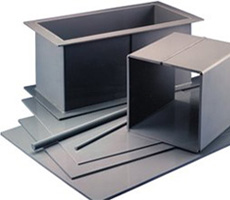CPVC / Corzan

Chlorinated polyvinyl chloride (CPVC) is a thermoplastic produced by chlorination of polyvinyl chloride (PVC) resin. Uses include hot and cold water pipe, and industrial liquid handling.
Although it is derived from PVC and thus shares some of that material’s characteristics, CPVC is a distinct polymer. It is a high-temperature-grade chlorinated polyvinyl chloride that is resistant to corrosion, heat, and chemicals. CPVC can be easily machined with standard woodworking tools and can be fiberglass-backed, hot-air welded with rod, cemented (solvent bonded), riveted, and threaded. This material is useful for a wide range of applications, from chemical processing to metal finishing.
Chlorinated Polyvinyl Chloride (CPVC) is PVC (polyvinyl chloride) that has been chlorinated via a free radical chlorination reaction. This reaction is typically initiated by application of thermal or UV energy utilizing various approaches. In the process, chlorine gas is decomposed into free radical chlorine which is then reacted with PVC in a post-production step, essentially replacing a portion of the hydrogen in the PVC with chlorine.
Depending on the method, a varying amount of chlorine is introduced into the polymer allowing for a measured way to fine tune the final properties. The chlorine content may vary from manufacturer to manufacturer; the base can be as low as PVC 56.7% to as high as 74% by mass, although most commercial resins have chlorine content from 63% to 69%.[citation needed] As the chlorine content in CPVC is increased, its glass transition temperature (Tg) increases significantly. Under normal operating conditions, CPVC becomes unstable at 70% mass of chlorine.
Various additives are also introduced into the resin in order to make the material processable. These additives may consist of stabilizers, impact modifiers, pigments and lubricants.
Comparison to polyvinyl chloride (PVC)
Heat resistance
CPVC can withstand corrosive water at temperatures greater than PVC, typically 40°C to 50°C (104°F to 122°F) or higher, contributing to its popularity as a material for water piping systems in residential as well as commercial construction.
Mechanical properties
The principal mechanical difference between CPVC and PVC is that CPVC is significantly more ductile, allowing greater flexure and crush resistance. Additionally, the mechanical strength of CPVC makes it a viable candidate to replace many types of metal pipe in conditions where metal's susceptibility to corrosion limits its use.
Fire properties
CPVC is similar to PVC in resistance to fire. It is typically very difficult to ignite and tends to self-extinguish when not in a directly applied flame.
Due to its chlorine content, the incineration of CPVC, either in a fire or in an industrial disposal process, can result in the creation of chlorinated dioxins.
Physical properties
CPVC shares most of the features and properties of PVC. It is also readily workable, including machining, welding, and forming. Because of its excellent corrosion resistance at elevated temperatures, CPVC is ideally suited for self-supporting constructions where temperatures up to 200 °F (90 °C) are present. Due to its specific composition, dealing with CPVC requires a specialized solvent cement, with high strength solvent cement variants being first introduced in 1997 by Weld-On, then followed closely by other products such as Henkel's Tangit line. The ability to bend, shape, and weld CPVC enables its use in a wide variety of processes and applications. It exhibits fire-retardant properties.
Key Properties
Good impact properties
Resistant to corrosion, heat, and chemicals
Inherent flame resistivity
Easily machined
Retains physical properties at high temperatures
Standard Shapes and Forms
Sheet: .030” – 2” thick
Rod: .250” – 7” diameter
Tubular Bar: 1.625” – 6.625” OD / .562” – 4” ID
Other Forms: Welding rod, Profiles: hex rod, angle and Pipe & Fittings
A Corrosion Guide is available on the Pipe & Fittings page and the Technical Specifications page.
The range of sizes and shapes are grade specific, please contact us for more information.
Colors
Light gray – standard
TYPICAL PROPERTIES OF CORZAN/CPVC
ASTM or ULtest Property Units Value
PHYSICAL
D792 Specific Gravity g/cm3 1.47
D570 Water Absorption % 0.03
D785 Rockwell Hardness R Scale 116
D1784 Cell Class - 24446-B
MECHANICAL
D256 Izod Impact (Notched) ft-lb/in o.n. 9
D638 Tensile Strength psi 7300
D790 Flexural Strength psi 14,300
D790 Flexural Modulus psi 361,000
D695 Compressive Strength psi 10,100
D695 Compressive Modulus psi 196,000
THERMAL
D696 Coefficient of Thermal Expansion in/in/°F 3.86 × 10^-5
C177 Thermal Conductivity BTU/in/hr/ft3/°F 0.95
D648 Heat Distortion Temperature @ 264 psi °C /°F 92/198
FLAMMABILITY RATINGS
UL94 Flammability V-0, 5VB, 5VA 0.062"
E84 Flame Spread - 15
D2863 Limiting Oxygen Index % 60
ELECTRICAL
D147 Dielectric Strength Volt/MIL 1250
D150 Dielectric Constant 60 HZ 3.70
D150 Power Factor 1000 HZ 0.007%
D257 Volume Resistivity Ohm/cm 3.4 × 10^15
CPVC / Corzan Pictures



Get an instant offer on your damaged car

Get an offer instantly
Just tell us a bit about your car and boom, there's your offer.

Free pickup
You have seven days to accept our offer and schedule pickup.

Get paid on the spot
Our pickup partner will do a quick inspection, and hand you a check.